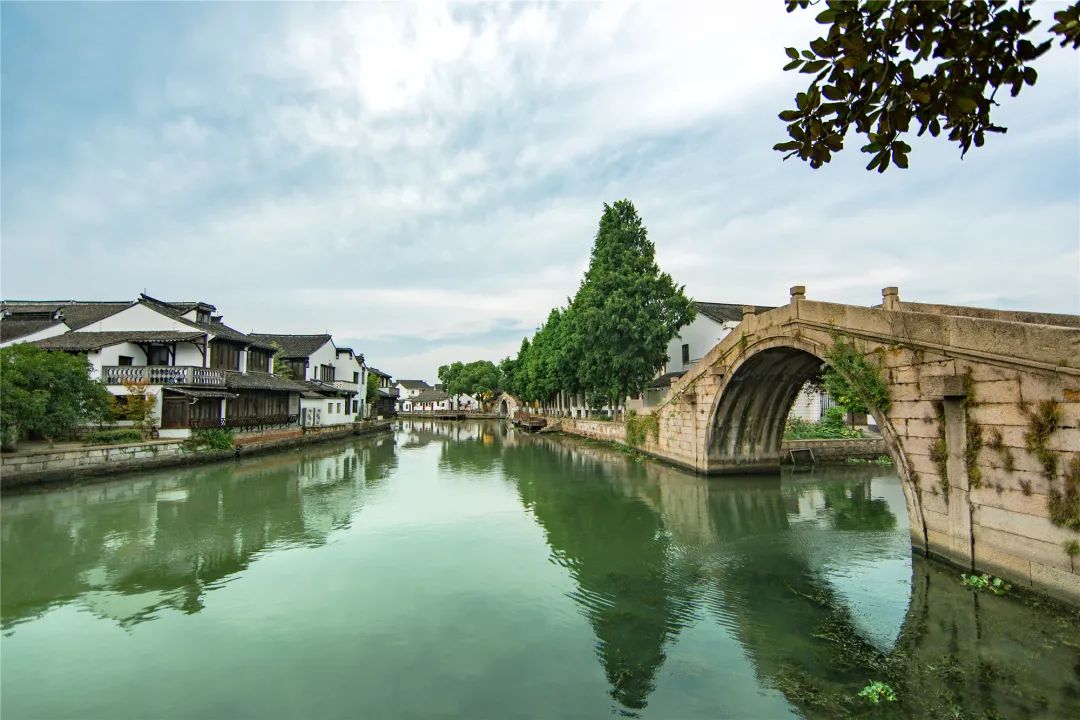Click “cultural Shanghai” above to subscribe! Jinze town is located in the southwest of Qingpu District and on the Bank of Dianshan Lake
. 
It was announced as the Sixth Batch of Chinese historical and cultural towns in 2014
. 
The ancient town has a long history
. 
It is said that it flourished in Song Dynasty and flourished in Yuan Dynasty
. 
Due to the concentration of ancient bridges in song, yuan, Ming and Qing Dynasties, Jinze is praised as “Ancient Bridge Museum” and “Jiangnan bridge town”
. 
Qian Juntao, a famous calligrapher and seal cutter, once wrote “Jinze ancient bridge is the best in the world”
. 
Origin: Dianshan Lake, according to the water and the ancient bridge built because of water, water village because of the bridge
. 
The ancient bridge in Jinze town is a treasure left by history and the charm of Jiangnan water town culture
. 
According to historical records, there was “forty two Hongqiao” in ancient Jinze
. 
“When you go out, you will cross the bridge, and others will pillow the river as much as possible”, “the wind and bamboo on the wall will move, and the water lane and small bridge will connect”, and the artistic conception of Qiaoxiang is wonderful
. 
There are seven ancient bridges in the water area of jinzetang across the ancient town, which span the song, yuan, Ming and Qing Dynasties in various forms
. 
The Song Dynasty Puji bridge of Ruyi bridge in Jinze is a stone arch bridge built in the third year of Xianchun (1267)
. 
It uses purple Wukang stone and is commonly known as “purple stone bridge”
. 
Arc arch, so gentle slope, low guardrail, no decoration, simple and elegant
. 
Tang Huancheng, a contemporary bridge expert, said: “on the antiquity of Shanghai’s ancient bridges, we should promote the Jinze Puji bridge.” Yingxiang bridge of Puji bridge in Yuan Dynasty was built in 1335-1340
. 
It is a five span continuous simple supported girder bridge with mixed structure of blue brick, water mill square brick, nanmu and bluestone
. 
As a famous Yuan Dynasty bridge in Jiangnan, it not only has high historical, artistic and scientific value, but also is called the originator of “continuous simply supported” beam bridge by contemporary bridge experts
. 
Yingxiang bridge Tianwang bridge of Ming Dynasty (also known as tianhuangge bridge) is a three arch stone bridge made of bluestone and granite
. 
It was built in Ming Dynasty and rebuilt in 1698
. 
The arch of the bridge is as high as half a moon, flexible and beautiful
. 
The decoration of the bridge is various, including stone in the center of the bridge, couplets, stone lion pillar, cirrus cloud drum stone, etc
. 
the bridge deck is carved with eight immortals
. 
The bridge of Tianwang bridge in Qing Dynasty is to repair and transform the ancient bridges to prolong their service life
. 
Seven ancient bridges have historical records of reconstruction in Qing Dynasty
. 
The Ruyi bridge was built in the Yuan Dynasty and rebuilt in 1899
. 
The reconstructed Ruyi bridge is completely in the style of the Qing Dynasty
. 
It is tall in shape, with solid granite
.
The bridge deck is decorated with guardrails, watchposts, drum stones, especially couplets
.
The beauty of scenery, shape, carving and decoration of Ruyi bridge and its combination with engineering art make it a unique architectural art treasure
.
Repair of stone carving: welcome the auspicious night moon and reappear the beautiful scenery
.
Although the ancient bridge in Jinze has a long history, it is well preserved due to timely maintenance
.
In 2015, Yingxiang bridge, a cultural relic protection unit in Shanghai, was repaired
.
In order to fully understand the disease, modern detection technology was used before repair
.
The investigation found that the wooden beams of the ancient bridge were decayed and split, the stone columns and beams were inclined, deviated and fractured, and the surface layer of green bricks also had irregular subsidence
.
The repair works suit the remedy to the case: all Phoebe beams shall be protected against water and corrosion after renovation; rotten pine beams and warped cypress beams shall be replaced with Chinese fir; rotten wood watchboards shall be replaced with anti-corrosion and mothproofing treatment; broken cap stones shall be repaired; and green bricks shall be laid again after cleaning
.
After the repair, the Yingxiang bridge renovation project adheres to the principle of “repair as old”, fully protects and utilizes the original components, retains the original features of the cultural relics to the greatest extent, and reproduces the “Yingxiang night moon” beauty of “moon printing, river flow, water and sky color”
.
Folk custom: bridges have temples, temples have bridges
.
The ancient bridge in Jinze is not only a traffic facility for residents to remove obstacles in the river, but also the lifeblood of social customs
.
In the history of Jinze, “bridges have temples, temples have bridges.” temples pick bridges, bridges pick temples, and even build temples on bridges
.
The name of the bridge is also related to religious belief
.
This unique folk custom of bridge temple is very rare in China
.
Fangshengqiao and Guanguan temple in Jinze today’s temple only has Yihao Temple site and Guanguan temple in Yuan Dynasty, but also has left numerous mysterious legends and anecdotes, among which the legend of “Baipo bridge” is quite interesting
.
During the reign of song JINGDING (1260-1264), there was a simple bridge in the middle of Shihe River, which was an important traffic point leading to Yihao temple
.
Pilgrims had to pay the bridge builder for passing by, which made the town’s grandmother angry
.
So more than a hundred old women who made a living by spinning and weaving gathered to discuss building the bridge
.
They all believe that building a bridge is a matter of doing good deeds and accumulating virtue
.
After a year’s efforts, they jointly built a three hole stone pier bridge on the main road of Shihe River, which is free for villagers
.
In memory of their merits, the bridge was named Baipo bridge
.
In the Qing Dynasty, “Baipo Mingyue” was also included in the “eight scenes of Jinze”
.
Although Baipo bridge has been submerged in history, the goodwill it conveys has been lasting
.
Tianwang bridge dark eight immortals carving opening hours, tickets, booking information: open all day, no tickets
.
Traffic information: (1) east Lvzhou station of rail transit line 17 – section of Qingjin line to Jinze bus station (2) Shanghai Shang high speed line (Danshui road Changle Road Station) – clock in place of Jinze bus station scenic spot 01 the oldest bridges in Shanghai: Wan’an bridge and Puji bridge were built in 1260-1264 of the Song Dynasty
.
Wan’an bridge is located in Shangtang street, which is a typical Song Dynasty single span bridge with Puji bridge in Xiatang street Stone arch bridge
.
This pair of Shanghai’s oldest “sister bridges” span jinzetang, and have been on watch from north to south for thousands of years
.
Puqing bridge, built in 1999, is an imitation of the bianshui Rainbow Bridge in the picture of Qingming River
.
The whole bridge has no tenon, no nails, all tied up with binding
.
This is a masterpiece of contemporary bridge restoration, and also a tribute to the wisdom of our ancestors
.
03 the originator of continuous simply supported beam bridge: Yingxiang bridge, located in the south of the ancient town, “Hongying is surrounded by wide Yanzhu, with bright moon hanging high and strong night view”, which describes the beautiful scenery of “Yingxiang night moon” in eight scenes of Jinze
.
Lin Laoqiao, the first bridge in the north of the ancient town, was built in the Yuan Dynasty and rebuilt in 1730
.
The single hole stone arch bridge, with gentle slope and low guardrail, retains the posture of stone arch bridge in Song Dynasty
.
In the process of repair and maintenance in the Ming and Qing Dynasties, the stone was replaced by bluestone and granite, the lookout post was added, and the dark eight immortals pattern was carved step by step, which can be called “mix and match” master
.
05 “qiaotiao Temple”: Tianwang bridge Tianwang bridge is located in Xiatang street
.
There used to be Tianwang temple in the north and Jesus Church in the south of the bridge
.
A bridge connects religious facilities across the river, which is called “qiaotiao Temple”
.
06 “bridges and temples depend on each other”: Jinze Fangsheng bridge is located in Xiatang street
.
It is also called Guanguan bridge because there is a Guanguan temple in the north of the bridge
.
The bridge was built in the Ming Dynasty and rebuilt in 1791
.
In the Republic of China, guardrails and watchposts were built
.
On the west side of the bridge is engraved: “the water flows out of the Bay, the beach is beautiful, and the bridge connects Ruyi with Kangqu.”
.
Yihao Temple Yihao temple is located on the east side of Puji bridge
.
It was founded in 1260, the first year of JINGDING in Song Dynasty
.
It was even larger than Lingyin Temple in Ming and Qing Dynasties
.
The building was destroyed by bombing in 1938
.
There are more than 700 years old ancient ginkgo biloba, inscriptions of Yihao temple in Yuan Dynasty, stone column foundation of main hall and continuous cloud stone inscriptions in Yuan Dynasty
.
The majestic stone carvings are made by Zhao Mengfu, a famous calligrapher and painter of the Yuan Dynasty
.
Qingxi country park Qingxi country park is located at No.500 Zilian Road, Jinze Town, Qingpu District
.
With Dalian Lake as the core, nearly one third of the park is covered by water
.
It is the only country park with wetland characteristics in Shanghai
.
No ticket, Shanghai travel code reservation
.
Opening time: 8:30-16:30, and visitors are not allowed to enter the ecological conservation zone at 16:00
.
02 Lianhu village, a village growing in the park, is the only original village in the core area of Qingxi country park
.
The village is crisscrossed with rivers and lakes, idyllic scenery, well arranged houses, and simple and elegant rural style.
.



